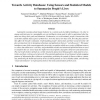Free Online Productivity Tools
i2Speak
i2Symbol
i2OCR
iTex2Img
iWeb2Print
iWeb2Shot
i2Type
iPdf2Split
iPdf2Merge
i2Bopomofo
i2Arabic
i2Style
i2Image
i2PDF
iLatex2Rtf
Sci2ools
120
click to vote
DEBU
2006
2006
Towards Activity Databases: Using Sensors and Statistical Models to Summarize People's Lives
Automated reasoning about human behavior is a central goal of artificial intelligence. In order to engage and intervene in a meaningful way, an intelligent system must be able to understand what humans are doing, their goals and intentions. Furthermore, as social animals, people's interactions with each other underlie many aspects of their lives: how they learn, how they work, how they play and how they affect the broader community. Understanding people's interactions and their social networks will play an important role in designing technology and applications that are "socially-aware". This paper introduces some of the current approaches in activity recognition which use a variety of different sensors to collect data about users' activities, and probabilistic models and relational information that are used to transform the raw sensor data into higher-level descriptions of people's behaviors and interactions. The end result of these methods is a richly s...
| Added | 11 Dec 2010 |
| Updated | 11 Dec 2010 |
| Type | Journal |
| Year | 2006 |
| Where | DEBU |
| Authors | Tanzeem Choudhury, Matthai Philipose, Danny Wyatt, Jonathan Lester |
Comments (0)

